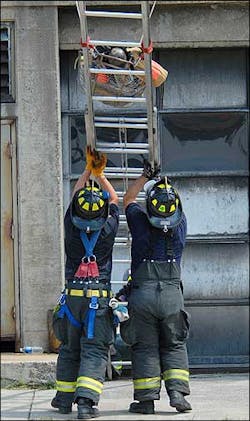Montgomery County, Md. Shows Off Advances in Training during Expo
ROCKVILLE, Md.-- It's important that all incident commanders are on the same sheet of music regardless of the patch on their sleeve.
And, training officers in Montgomery County aren't just talking about it. They've created a unique center that allows commanders and firefighters to assume various roles.
Montgomery County Fire Chief Tom Carr sees the new opportunity as a win-win situation. "All the stakeholders -- career and volunteers -- were involved in its development. It's been well-received. I think it's very critical that everyone know what's expected of them."
One part of the building resembles a computer lab with various work stations. In another area, there's a large tabletop display featuring communities similar to those in Montgomery County. In addition to various types of houses, there are parking garages, hospitals, strip malls and construction sites.
There are model ambulances, ladder trucks, commercial vehicles, cars, airplanes and other vehicles. There are simulated plane crashes and a tornado.
But this is no game, said Joel Woods, who helped design the set. "It makes people think outside the box. They look at things around the site of their incident, and make decisions. It's the same thing they would be forced to do at a real scene."
Panels can be changed out, and there are boxes of model vehicles. Officers get the opportunity to test what they've learned in the classroom.
Carr said the concepts boost confidence. "People are learning that they can do the job. It's a challenge, but they're learning. That's what this is all about."
The chief added that personnel understand the seriousness of the tabletop lab exercise. "They have to take a written test. It's tough. It's not our goal to weed anyone out. But, teach them. They rotate through the various positions."
The true test doesn't come from an instructor or sitting at a computer screen. The final exam occurs at the scene of an emergency. "Regardless of who is in charge at an incident -- a volunteer or a career person -- they've all been trained the same. That's why it's here."
On Wednesday afternoon, personnel attending Firehouse Expo training were given the opportunity to practice their skills. Jerry Ozog, from Hampden Township in Cumberland County, Pa., volunteered to be incident commander.
While he took a seat in a vehicle in an adjoining garage, and became acquainted with the radio and command charts, others were being assigned various tasks in another room. They were handed model fire trucks, ladder trucks, squads and ambulances. Everyone had a radio.
Once the team was ready, a house fire was dispatched. The units went on the air responding as they would in a real situation. A two-story house with fire showing from two windows was displayed on a large screen.
Ozog could see it as well, but he had to rely on his officers to keep him abreast of the progress. He jotted down the units, and the assignments and led the fire based on what his various division commanders were telling him. The firefighters also had to choose the correct hoses, and placement of equipment.
Throughout the exercise, there was discussion between the training officer and the students. The various departments' SOPs and terminology made the drill even more educational, the participants said.
When the fire was declared under control, Ozog emerged from his vehicle and declared he felt the stress.
"It was very challenging. It truly simulates what a commander would face. Montgomery County should be congratulated. It was very valuable. To be able to sit in the vehicle with all the tools -- the worksheets, radio -- it was incredible."
In another room, another group of Firehouse Expo participants were sitting at various computer stations. Each was assigned a different task.
A training officer sent different pictures to each screen, depending on the assignment. One person saw an interior hallway, while another saw the fire from the rear of the building.
Again, the incident commander depended on the others for reports.
A sign in the center reads: "What I hear, I forget. What I see, I remember. What I do, I understand."
